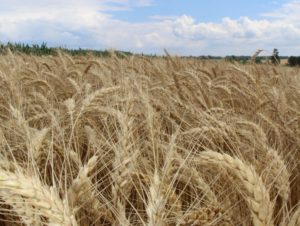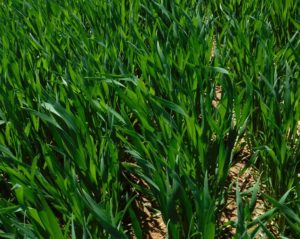Menu
Wheat Management Tips for Yield & Quality
We’ve just come through a challenging fall and winter for wheat, and it’s time to evaluate the crop to determine how best to maximize yield and profitability this season. As the wheat crops breaks dormancy, it’s a good time to check stand counts. To verify we have enough plants per acre to sustain our yield goals, I like to see 25-40 plants per square foot, with each plant carrying 3-5 tillers. Ideally, we want to achieve 60-80 heads per square foot, to hit a yield target at or above 100 bu/acre. Each mature head per square foot, can represent 1.25-1.5 bushel per/acre. If you have fields with less than 20 plants per square foot, you may want to plant another crop such as corn or soybeans to maximize your profit potential in 2019.
Match up your fertility program to your yield potential
Apply 1.2-1.5 units of Nitrogen for every expected bushel of yield. Peak Nitrogen uptake occurs between Feekes stage 6 & 10. If your wheat is small, or thinner than you like, don’t delay putting down Nitrogen. An early Nitrogen boost can really enhance tillering, setting up bigger yields. Split applications of Nitrogen are preferable.
Check on Phosphorus & Other Micro-Nutrients

Phosphorus is sometimes overlooked in wheat production, but is critical to tiller growth. Most all of your yield comes from 3 stems, the main stem, the T1 stem, and the T2 stem. The T1 stem begins to form when the primary stem reaches the 2-3 leaf stage, and the T2 stem begins to develop about a week later. If the plant has limited availability of Phosphorus during this critical growth stage, tiller development is stunted, and yields will be impacted. Sulfur and several other micro-nutrients such as Copper, Boron, and Zinc are important in high yield wheat. High quality wheat is vital to maximize profitability, and the use of fungicide to control diseases and head scab are recommended.
Falling Numbers

Recent research has highlighted another opportunity to manage wheat quality. When you take a load to the grain elevator, they test it for Falling Numbers. Falling Numbers measure the amount of alpha-amylase that is active in the kernel of wheat. When wheat reaches physiological maturity, it goes through a dormancy period before germination can occur. Once through the dormancy period, any moisture or heavy rainfall event can trigger the seed to produce alpha-amylase. This is the natural process of the seed utilizing alpha-amylase to break down the starch in the kernel to feed the new seedling as it sprouts and begins to grow. The breakdown of the starch reduces the Falling Number, affecting the quality of your wheat. Low Falling Number wheat makes poor bread or pretzel dough.
Consider Applying Molybdenum to Wheat
Recently, agronomists and growers have begun to apply Molybdenum to wheat. Studies have shown that Molybdenum can extend the length of the kernel dormancy period in wheat by up to 2 weeks. This extension of kernel dormancy gives you a longer window to harvest a high-quality crop, with a higher Falling Number, improving your profit opportunity. Applying 1 qt/acre of MolyPower along with your spring application of Nitrogen and another 1 qt/acre around flag leaf timing is recommended.
Other Factors that Affect Falling Numbers
It is always best to harvest wheat timely to ensure grain quality, but we also know that harvesting mature wheat that is green, will result in higher than normal alpha-amylase levels as well. Weather can trigger an increase in alpha-amylase production. Cold temperature shock, 25-30 days following pollination will induce higher alpha-amylase levels. Daytime temperature below 65 degrees and nighttime temperatures that dip below 45 degrees, will have an impact.


